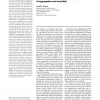Free Online Productivity Tools
i2Speak
i2Symbol
i2OCR
iTex2Img
iWeb2Print
iWeb2Shot
i2Type
iPdf2Split
iPdf2Merge
i2Bopomofo
i2Arabic
i2Style
i2Image
i2PDF
iLatex2Rtf
Sci2ools
110
click to vote
AC
2003
Springer
2003
Springer
The Importance of Aggregation
Abstract—The dynamics of the survival of recruiting fish are analyzed as evolving random processes of aggregation and mortality. The analyses draw on recent advances in the physics of complex networks and, in particular, the scale-free degree distribution arising from growing random networks with preferential attachment of links to nodes. In this study simulations were conducted in which recruiting fish 1) were subjected to mortality by using alternative mortality encounter models and 2) aggregated according to random encounters (two schools randomly encountering one another join into a single school) or preferential attachment (the probability of a successful aggregation of two schools is proportional to the school sizes). The simulations started from either a “disaggregated” (all schools comprised a single fish) or an aggregated initial condition. Results showed the transition of the school-size distribution with preferential attachment evolving toward a scale-free school si...
Related Content
| Added | 06 Jul 2010 |
| Updated | 06 Jul 2010 |
| Type | Conference |
| Year | 2003 |
| Where | AC |
| Authors | Robbert van Renesse |
Comments (0)

